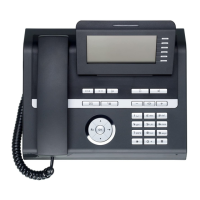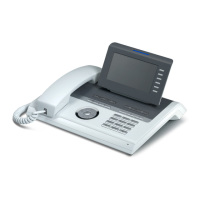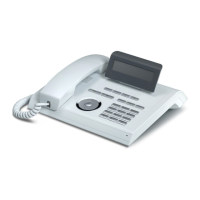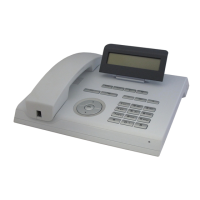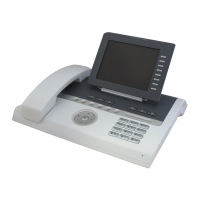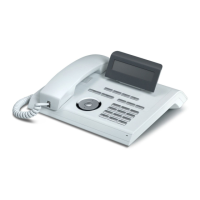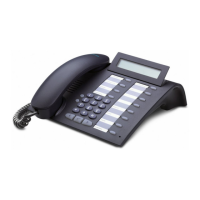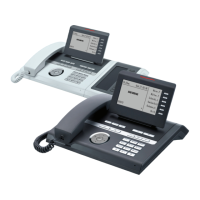Do you have a question about the Siemens OpenStage 40 and is the answer not in the manual?
Information on CE marking, product disposal, and safety guidelines for operation.
Recommendations for phone placement and details on accessing online product support.
Description of the user guide's scope and explanation of symbols used.
Details on contacting service, intended use, and optimizing phone performance.
Explanation of the phone's multi-line features and usage.
Information on encrypted call features and indicators.
Methods for receiving incoming calls via handset, speakerphone, or headset.
How to answer calls for absent colleagues or retrieve colleague's held calls.
Managing multiple calls, call waiting, and call switching.
Instructions for dialing, redialing, and using special line functions.
Setting up call forwarding rules and requesting callbacks.
Joining multiple callers into a single conference call.
A comprehensive list of functions that can be assigned to sensor keys.
Methods for assigning functions to sensor keys via the phone or web interface.
Restoring programmed sensor keys to their factory default settings.
Procedures for accepting, deflecting, or rejecting incoming calls.
Placing active calls on hold and retrieving them.
Managing a second incoming call during an active call.
Methods for transferring calls with or without consultation.
Setting up and managing local and system-based conference calls.
Creating, editing, and deleting personal contact entries.
Accessing and searching corporate directories via LDAP.
Viewing, editing, and deleting call history records.
Enabling or disabling the logging of call history.
Managing incoming calls for primary and secondary lines.
Selecting lines for outgoing calls manually or automatically.
Managing calls on single and multiple lines, including waiting calls.
Using DSS keys for direct calls, consultations, and call pickups.
Scenarios and procedures for managing calls within a team structure.
Deactivating the phone's ringer via key or menu.
Enabling and configuring the DND feature via key or menu.
Setting, changing, and deactivating user passwords for phone access.
Securing the phone against unauthorized access by locking the device.
Overview of mobility features and use cases for logging on/off.
Steps for logging on and off as a mobility user.
Logging in remotely with forced or delayed logoff.
Using keys to switch OpenScape Voice features on/off.
Controlling caller ID display and handling anonymous calls.
Creating lists for accepting or rejecting specific callers.
Managing hunt group assignments and line busy status.
Procedures for parking and retrieving calls for colleagues.
Listening to calls discreetly, with or without party knowledge.
Using one-way and two-way intercom features for internal communication.
Adjusting screen angle, contrast, and brightness for optimal viewing.
Setting the device's date, time, and daylight saving preferences.
Adjusting volume levels for loudspeaker, ringer, handset, and headset.
Choosing ringtones, melodies, and tone sequences.
Selecting phone language and country-specific configurations.
Viewing IP address, web interface URL, and network activity data.
Returning user-specific settings to factory defaults.
Available modes: Manual, AutoStart, All Calls, and Disabled.
Procedures for activating, deactivating, and controlling manual call recording.
Automatic recording of all calls when a call is active.
Handling consultations and second calls while recording.
Steps to connect to the phone's web interface via browser.
Accessing user-specific settings and making changes via the web interface.
Managing contact entries within the phonebook through the web interface.
Guidelines for cleaning the phone and resolving common issues.
Information on whom to contact for assistance with faults or problems.
Methods for labeling keys on the OpenStage Key Module.
Steps to open and navigate the phone's menu system.
An overview of the various settings accessible via the user menu.
Available functions for programming keys on Normal and Shifted levels.
Information on CE marking, product disposal, and safety guidelines for operation.
Recommendations for phone placement and details on accessing online product support.
Description of the user guide's scope and explanation of symbols used.
Details on contacting service, intended use, and optimizing phone performance.
Explanation of the phone's multi-line features and usage.
Information on encrypted call features and indicators.
Methods for receiving incoming calls via handset, speakerphone, or headset.
How to answer calls for absent colleagues or retrieve colleague's held calls.
Managing multiple calls, call waiting, and call switching.
Instructions for dialing, redialing, and using special line functions.
Setting up call forwarding rules and requesting callbacks.
Joining multiple callers into a single conference call.
A comprehensive list of functions that can be assigned to sensor keys.
Methods for assigning functions to sensor keys via the phone or web interface.
Restoring programmed sensor keys to their factory default settings.
Procedures for accepting, deflecting, or rejecting incoming calls.
Placing active calls on hold and retrieving them.
Managing a second incoming call during an active call.
Methods for transferring calls with or without consultation.
Setting up and managing local and system-based conference calls.
Creating, editing, and deleting personal contact entries.
Accessing and searching corporate directories via LDAP.
Viewing, editing, and deleting call history records.
Enabling or disabling the logging of call history.
Managing incoming calls for primary and secondary lines.
Selecting lines for outgoing calls manually or automatically.
Managing calls on single and multiple lines, including waiting calls.
Using DSS keys for direct calls, consultations, and call pickups.
Scenarios and procedures for managing calls within a team structure.
Deactivating the phone's ringer via key or menu.
Enabling and configuring the DND feature via key or menu.
Setting, changing, and deactivating user passwords for phone access.
Securing the phone against unauthorized access by locking the device.
Overview of mobility features and use cases for logging on/off.
Steps for logging on and off as a mobility user.
Logging in remotely with forced or delayed logoff.
Using keys to switch OpenScape Voice features on/off.
Controlling caller ID display and handling anonymous calls.
Creating lists for accepting or rejecting specific callers.
Managing hunt group assignments and line busy status.
Procedures for parking and retrieving calls for colleagues.
Listening to calls discreetly, with or without party knowledge.
Using one-way and two-way intercom features for internal communication.
Adjusting screen angle, contrast, and brightness for optimal viewing.
Setting the device's date, time, and daylight saving preferences.
Adjusting volume levels for loudspeaker, ringer, handset, and headset.
Choosing ringtones, melodies, and tone sequences.
Selecting phone language and country-specific configurations.
Viewing IP address, web interface URL, and network activity data.
Returning user-specific settings to factory defaults.
Available modes: Manual, AutoStart, All Calls, and Disabled.
Procedures for activating, deactivating, and controlling manual call recording.
Automatic recording of all calls when a call is active.
Handling consultations and second calls while recording.
Steps to connect to the phone's web interface via browser.
Accessing user-specific settings and making changes via the web interface.
Managing contact entries within the phonebook through the web interface.
Guidelines for cleaning the phone and resolving common issues.
Information on whom to contact for assistance with faults or problems.
Methods for labeling keys on the OpenStage Key Module.
Steps to open and navigate the phone's menu system.
An overview of the various settings accessible via the user menu.
Available functions for programming keys on Normal and Shifted levels.
| Voice codecs | G.711, G.722, G.729 |
|---|---|
| Noise reduction | Yes |
| Caller ID | - |
| Phonebook capacity | - entries |
| Display resolution | 240 x 128 pixels |
| Ethernet LAN (RJ-45) ports | 1 |
| Mounting | Desk/Wall |
| Product type | IP Phone |
| Product color | Grey, White |
| Dimensions (WxDxH) | 270 x 220 x 70 mm |
| Storage temperature (T-T) | -40 - 70 °C |
| Operating temperature (T-T) | 5 - 40 °C |
| Weight | 1068 g |
|---|
